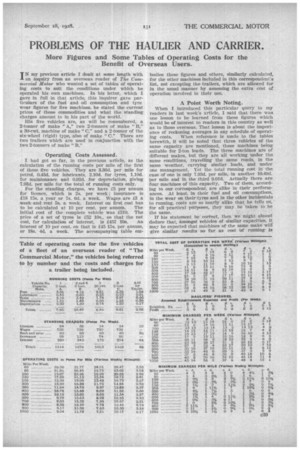PROBLEMS OF THE HAULIER AND CARRIER.
Page 23

Page 24

If you've noticed an error in this article please click here to report it so we can fix it.
More Figures and Some Tables of Operating Costs for the Benefit of Overseas Users.
IN my previous article I dealt at some length with an inquiry from an overseas reader of The Commercial Motor who wanted a set of tables of operating costs to suit the conditions under which he operated his own machines. In his letter, which I gave in full in that article, this inquirer gave particulars of the fuel and oil consumption and tyre wear figures for five machines. he stated the current prices of those commodities and what the standing charges amount to in his part of the world.
His five vehicles are, as will he remembered, a 2-tonner of make " A," two 2-tonners of make "B," a 30-cwt. machine of make "C," and a 2-tonner of the six-wheel (rigid) type, also of make "0." There are two trailers which are used in conjunction with the two 2-tonners of make "B."
Operating Costs Assessed.
I had got so far, in the previous article, as the calculation of the running costs per mile of the first of these five vehicles. They are 3.36d. per mile for petrol, 0.45d. for lubricants, 2.10d. for tyres, 1.10d. for maintenance and 0.92d. for depreciation, giving 7.93d. per mile for the total of running costs only.
For the standing charges, we have E5 per annum for licence, which is 2s. per week ; insurance is £18 15s. a year or is. 6d. a week. Wages are 13 a week and rent 5s. a week. Interest on first cost has
to be calculated at 10 per cent, per annum. The initial cost of the complete vehicle was £510. The price of a set of tyres is £52 10s., so that the net cost, for calculation of interest, is £457 10s. An interest of 10 per cent. on that is £45 15s. per annum, or 18s. 4d. a week. The accompanying table ern bodies these figures and others, similarly calculated, for the other machines included in this correspondent's list, not excepting the-trailers, which are allowed for In the usual manner by assessing the extra cost of operation involved in their use.
A Point Worth Noting.
When I introduced this particular query to my readers in last week's article, I said that there was one lesson to be learned from these figures which would be of interest to readers in this country as well as to those overseas. That lesson is about the importance of reckoning averages in any schedule of operat
ing costs. When reference is made to the tables herewith, it will be noted that three vehicles of the same capacity are mentioned, these machines being suitable for 2-ton loads. The three machines are of different makes, but they are all working under the same conditions, travelling the same roads, in the same weather, carrying similar loads, and under one management. Yet the total running cost in the case of one is only 7.93d. per mile, in another 10.49d. per mile and in the third 9.01d. Actually there are four machines of this capacity. Two of them, according to our correspondent, are alike in their performances. At least, in their fuel and oil consumptions, in the wear on their tyres and in the other incidentals to running, costs are so nearly alike that he tells us., for all practical purposes, they may be taken to be the same.
If his statement be correct, then 'wemight almost deduce that, amongst vehicles of similar capacities, it, may be expected that machines of the same make will give similar results so far as cost 'of running is concerned. Since, however, I am aware that is not so, I am going to• assume that we have the finning costs of only three machines of 2-tons capacity.
That means to say there is a difference in running costs, between the three, of as much as 2id. per mile (which is the difference between the highest and lowest) and, as the cost of one is practically Sd. and that of the other practically' 10id., the difference, expressed as a percentage of the lower one, is no less than 31.25 per cent.
Now, the comprehensive tables which have appeared in this journal and copies of which can be had gratis on application to the Editor, are prepared from figures collected from all kinds of sources, and relating to hundreds of vehicles. The difference between the highest and lowest of these is much more
than 31,25 per cent., large as that difference is, and readers may therefore expect that some variance may arise as between the figures published in The Commercial Motor and those which are the outcome of their own experiences. They are not, however, to deduce from this that the published tables are wrong, but merely that their own figures are better or worse than average. S. T. R.
































